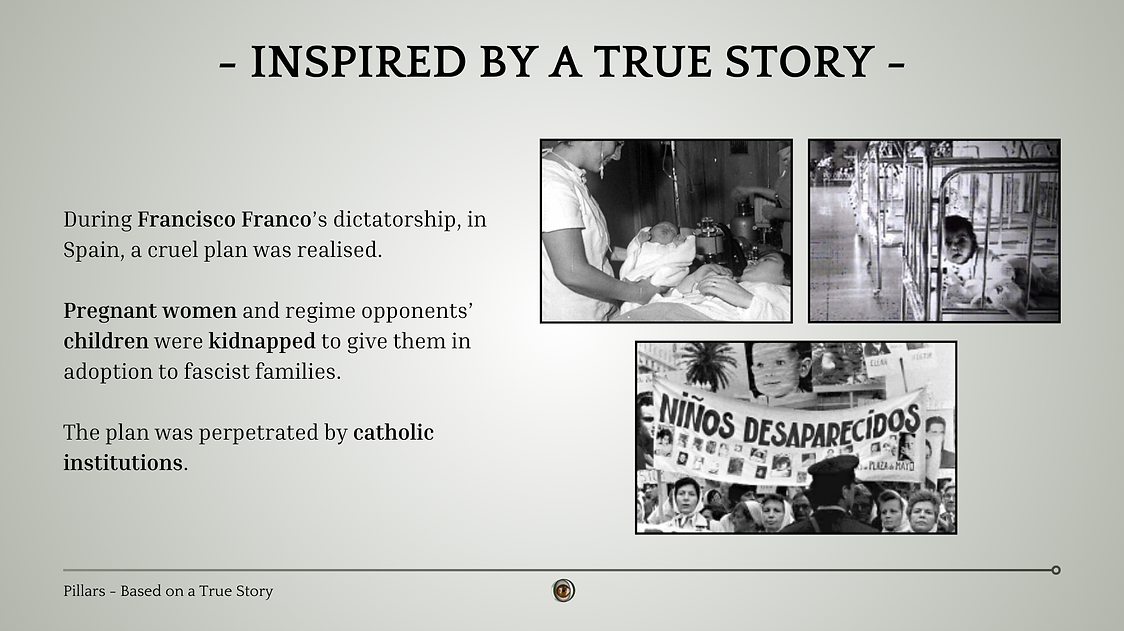Sacred Vendors

YEAR
ROLE
Work in progress
Gameplay designer, Level designer, Narrative designer
GENRE
ENGINE
Horror
Unreal Engine
DESCRIPTION
Sacred Vendors is a first-person horror game inspired by the "los niños robados por el Franquismo" scandal. Hide and escape from terrifying and grotesque adults who seek to kidnap you, while mastering your emotions through a sophisticated fear system grounded in psychological research.
Gameplay design
During the preproduction process, I established three guiding pillars, in collaboration with the team, to define what we can and can't do.
POV of a child
The mission is to authentically depict a child's perception of the world in frightening situations. This significantly influenced the design process.

Proportions
To effectively convey the sense of oppression and the gap between the child's world and the adult world, the proportions are intentionally altered. The protagonist is significantly smaller than the environment and, especially, the enemies.
Moreover, players can't fight enemies. They can just hide and flee.
Fear System
The fear system is conveyed through camera effects and auditory and visual hallucinations, developed with the guidance of a child psychologist specializing in PTSD.
To show its effects, it considers two parameters:
-
Proximity to known enemies
-
Discovery of frightening items
When players reach the 100% of fear, a new enemy, the fear monster, spawns in the map.
Never put the pad down
We want players to be fully immersed in gameplay at all times. This principle led to significant design decisions.

Subtractive design
The first principle was to eliminate any gameplay interruptions, such as cutscenes and quick-time events.
Furthermore, we chose to remove the traditional inventory system, providing players with only one usable object, whose quantity can be checked only diegetically.
Collectibles
But we have collectibles... When players find them, they appear as drawings depicting the child's fears. Consequently, we designed a hub set in your adult present where these drawings can be read as texts.
By the way, if players want to understand them during gameplay, they have to study and interpret them. So, it’s still part of the gameplay.
Inspired by a true story
Since the story is set during the Francoist era, historical accuracy is essential. Our aim is not to depict the historical events of the period but to craft a storytelling with significant emotional resonance

Inspired, not based
The story players experience is not a factual account of a child who lived through this terrible scandal. Instead, it is a fictional narrative that captures the feelings and emotions of those who endured it.
However, the entire aesthetic aspect remains historically accurate.
References
Every element in the game is the result of research, consultations with experts, and readings.
Additionally, the entire project is supported by a documentary filmmaker who has produced a film on the subject
Level Design
Tha main rule
Since the game is based on a fleeing mechanic, it is essential that there are never any dead ends. We utilized this rule to introduce a system of tunnels that are accessible only to players.
The flow
Each room is designed with a balance between movement options and elements that interact with the fear system.
Hiding spots
The placement of hiding spots is crucial for allowing players to find refuge not only during stealth phases but also to evade chases.
The first hospital section


Flow
Before drafting, I developed a gameplay flowchart to outline the main path and secondary routes, establishing a balanced wireframe from the start.
Throughout the drafting and blockout testing phases, the design evolved significantly, ultimately resulting in a central hub-style map that features expanding loops.
Loop system
The map employs a key system to divide it into distinct areas. There are three areas designed according to the following rules:
-
They must follow the structure of the three narrative acts: the first area is small and serves as an introduction, the second is large, and the third is small but densely packed with action
-
Each area should be thematically consistent and convey a sense of escalating danger
-
At the end of each area, players must return to the central hub

Narrative Design

The narrative system revolves around the goal of giving to players the opportunity to experience the levels in the order they prefer.
Past & Present
The whole game develops on two timeline:
-
PAST: 95% of the gameplay. You are a child
-
PRESENT: as an adult you can read collectibles and choose which level to play
Checkpoints
Each level has checkpoints. When players get caught by base enemies, they restart from the last one.
But, if players reach the 100% of fear and the fear monster catch them, they restart from the hub.
Whenever players return to a level they had left midway, they won’t start from the beginning but from the last checkpoint they had reached.